stencilled specialist decorating
A stencil is a made of thin impervious sheet material from which a pattern has been cut out, it is a mechanical method of allowing the cut out areas to receive paint whilst by default reserving the non cut areas from accepting paint. The term can refer to both the tool and the result.
The technique is used in both the traditional and modern interior and is an expedient and attractive way to run out repeating decorative ornament and design.
stencilled specialist decorating images
specialist decorating stencil work in practice
Because the paint is applied by hand the decorative artist can modify the colour and tone of the repeat during the stencilling process. The result is a customized finish with as much randomness and asymmetry as is required and obtainable within the confines of the method.
The overall effect can be further modified with washes and glazes as required. Complete schemes which are subsequently hand embellished are not uncommon. Stencilled murals and friezes work well in the appropriate period style for particular settings. Decorative stencil work is a long established approach for the decoration of historic interiors. In specialist decorating it is usual for the decorative artist to design bespoke templates for particular commissions although most artists are happy to work with retail designs too.
Complex designs can be built up using multi-separation stencils, producing a dynamic range of tonal and colour variation and detail. Akin to screen print methodology or to scenic hand blocked wallpapers these can be considered as stencilled murals. It is not infrequently the case that ornament so produced is hand embellished where large runs of a design are required for murals. See Stencil work in murals for an illustration of this.
historical context
Probably the earliest recorded use of the methodology is the outline of a hand in the caves of Lascaux, the human hand being used as a template to positively reserve the surface in a manner akin to the Victorian use of the fern leaf in the decoration of furniture.
The ancient civilizations of China and Japan developed highly evolved stencil techniques and these were used to decorate various items from clothing to ceramics.
In Europe the technique has been widespread as a decorative form since at least the late middle ages. During the Gothic and Renaissance periods in churches and the houses of the wealthy, the form was used extensively as a means of decoration and flourished alongside mural work. In England from the 1500's onwards examples can be found in secular as well as ecclesiastical buildings. Tudor and Jacobean artisans employed the stencil to provide simple ornamentation and panel systems. Later work imitated expensive cloth wall hangings and decorative stencilling attesting to this exists on examples of early match boarding. With the advent of wallpapers in the late Seventeenth century the imitation of this expensive luxury was undertaken straight onto the walls by means of the stencil, this usage continued into the late Eighteenth century. Indeed some of the early wallpapers were themselves created using the technique before wood block printing became more widespread.
Something of a lull during the Victorian period was offset by the Gothic Revival and architects William Burgess and George Gilbert Scott amongst others used stencilling along side specialist decorating quite extensively for furniture and interiors, usually in colour combinations evocative of the continental medieval period.
A revival of this decorative technique was championed by the Arts and Crafts movement and continued to flourish during the Art Nouveau period.
The use of the stencil for the running out of decorative ornament is a useful specialist decorating technique for the restoration of period and historic interiors and is an authentic means to this end.
The technique has found a contemporary audience with its use by guerilla artists such as Banksy and with his stencilled trompe l'oeils as well as its use more generally in agitprop murals especially in the late 1960's and the 70's.


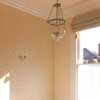 Specialist decorating stencilled bathroom
Specialist decorating stencilled bathroom Specialist decorating stencilled frieze
Specialist decorating stencilled frieze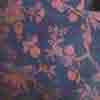 Chinoisery stencil specialist decoration
Chinoisery stencil specialist decoration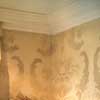 Stencil work restoration in a London residence
Stencil work restoration in a London residence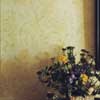 Historic Jacobean stencil in period room
Historic Jacobean stencil in period room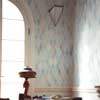 Art deco stencilled decoration in study
Art deco stencilled decoration in study